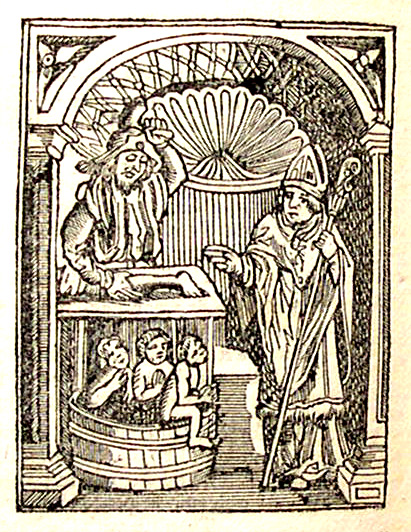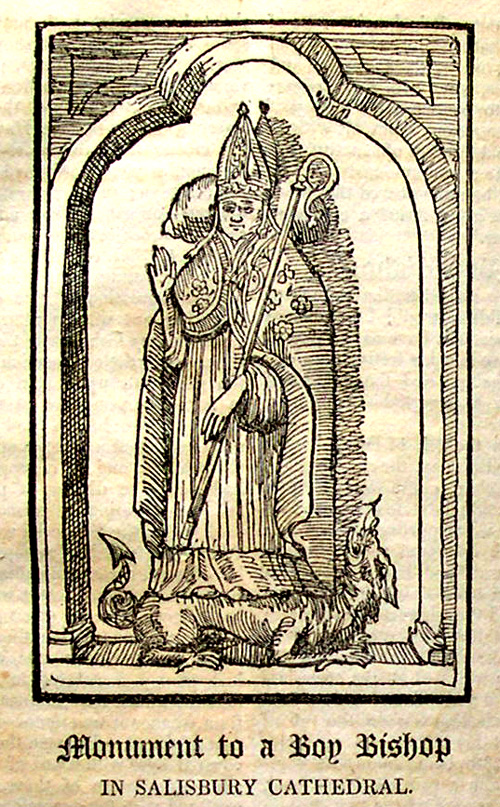December 6.
St. Nicholas, Abp. of Myra, A. D. 342. Sts. Dionysia, Dativa, Æmilianus, Boniface, Leontia, Tertius, and Majoricus, Martyrs. St. Peter Paschal, A. D. 1300. St. Theophilus, Bp. of Antioch, A. D. 190.
St. Nicholas.He is in the almanacs, and church of England calendar. He is patron or titular saint of virgins, boys, sailors, and the worshipful company of parish clerks of the city of London. Mr. Audley briefly observes of him, that he was remarkable in his infancy for piety, and the knowledge of the scriptures; that he was made bishop of Myra, in Lycia, by Constantine the Great, and that "he was present in the council of Nice, where, it is said, he gave Arius a box on the ear."*[1]
According to catholic story, St. Nicholas was a saint of great virtue, and disposed so early in life to conform to ecclesiastical rule, that when an infant at the breast he fasted on Wednesday and Friday, and sucked but once on each of those days, and that towards night.[2]† A story is related to his credit which is of considerable curiosity. It is told, that "an Asiatic gentleman" sent his two sons to "Athens" for education, and ordered them to wait on the bishop for his benediction. On arriving at Myra with their baggage they took up their lodging at an inn, purposing, as it was late in the day, to defer their visit till the morrow; but in the mean time the innkeeper, to secure their effects to himself, wickedly killed the young gentlemen, cut them into pieces, salted them, and intended to sell them for pickled pork. Happily St. Nicholas was favoured with a sight of these proceedings in a vision, and in the morning went to the inn, and reproached the cruel landlord with his crime, who immediately confessed it, and entreated the saint to pray to heaven for his pardon. Then the bishop, being moved by his confession and contrition, besought forgiveness for him, and supplicated restoration of life to the children; whereupon the pickled pieces reunited, and the reanimated youths stepping from the brine-tub threw themselves at the feet of St. Nicholas, who raised them up, exhorted them to return thanks to God alone, gave them good advice for the future, bestowed his blessing on them, and sent them to Athens with great joy to prosecute their studies.*[3]
The Salisbury missal of 1534, fol. xxvii. contains a prayer to St. Nicholas, before which is an engraving on wood of the bishop with children rising from the tub; but better than all, by a licence that artists formerly assumed of representing successive scenes in the same print, the landlord himself is shown in the act of reducing a limb into sizes suitable for his mercenary purpose. There are only two children in the story, and there are three in the tub of the engraving; but it is fairly to be conjectured, that the story was thought so good as to be worth making a little better. It is deemed seemly to introduce this narration by a fac-simile of the missal cut. Ribadeneira says of St. Nicholas, that "being present at the council of Nice, among three hundred and eighteen bishops, who were there assembled together to condemn the heresy of Arius, he shone among them all with so great clarity, and opinion of sanctity, that he appeared like a sun amongst so many stars." It will be remembered that he is affirmed to have given Arius a clarifying "box on the ear."
The Boy Bishop.If there were no other, the miracle of the pickled children would be sufficient to establish Nicholas's fame as the patron of youth, and we find his festival day was selected by scholars, and the children of the church, for a remarkable exhibition about to be described.
Anciently on the 6th of December, it being St. Nicholas's day, the choir boys in cathedral churches, chose one of their number to maintain the state and authority of a bishop, for which purpose the boy was habited in rich episcopal robes, wore a mitre on his head, and bore a crosier in his hand; and his fellows, for the time being, assumed the character and dress of priests, yielded him canonical obedience, took possession of the church, and except mass, performed all the ecclesiastical ceremonies and offices. Though the boy bishop's election was on the 6th of December, yet his office and authority lasted till the 28th, being Innocents' day.
It appears from a printed church book containing the service of the boy bishop set to music, that at Sarum,*[4] on the eve of Innocents' day, the boy bishop and his youthful clergy, in their copes, and with burning tapers in their hands, went in solemn procession, chanting and singing versicles as they walked into the choir by the west door, in such order that the dean and canons went foremost, the chaplains next, and the boy bishop with his priests in the last and highest place. He then took his seat, and the rest of the children disposed themselves on each side of the choir upon the uppermost ascent, the canons resident bore the incense and the book, and the petit-canons the tapers according to the Romish rubric. Afterwards the boy bishop proceeded to the altar of the Holy Trinity, and All Saints, which he first censed, and next the image of the Holy Trinity, while his priests were singing. Then they all chanted a service with prayers and responses, and the boy bishop taking his seat, repeated salutations, prayers, and versicles, and in conclusion gave his benediction to the people, the chorus answering, Deo gratias. Having received his crosier from the cross-bearer other ceremonies were performed; he chanted the complyn; turning towards the quire delivered an exhortation; and last of all said, "Benedicat Vos omnipotens Deus, Pater, et Filius, et Spiritus Sanctus."
By the statues of the church of Sarum, for the regulation of this extraordinary scene, no one was to interrupt or press upon the boy bishop and the other children, during their procession or service in the cathedral, upon pain of anathema. It farther appears that at this cathedral the boy bishop held a kind of visitation, and maintained a corresponding state and prerogative; and he is supposed to have had power to dispose of prebends that fell vacant during his episcopacy. If he died within the month he was buried like other bishops in his episcopal ornaments, his obsequies were solemnized with great pomp, and a monument was erected to his memory, with his episcopal effigy.
About a hundred and fifty years ago a stone monument to one of these boy bishops was discovered in Salisbury cathedral, under the seats near the pulpit, from whence it was removed to the north part of the nave between the pillars, and covered over with a box of wood, to the great admiration of those, who, unacquainted with the anomalous character it designed to commemorate, thought it "almost impossible that a bishop should be so small in person, or a child so great in clothes."
Mr. Gregorie found the processional of the boy bishop. He notices the same custom at York; and cites Molanus as saying, "that this bishop in some places did reditat census, et capones annuo accipere, receive rents, capons, &c. during his year," &c. He relates that a boy bishop in the church of Cambray disposed of a prebend, which fell void during his episcopal assumption to his master; and he refers to the denunciation of the boy bishop by the council of Basil which, at the time of the holding of that council, was a well-known custom. Mr. Gregorie, who was a prebendary of Salisbury, describes the finding of the boy bishop's monument at that place, and inserts a representation of it in his treatise, from which the annexed engraving is taken.
Monument to a Boy BishopIN SALISBURY CATHEDRAL.
The ceremony of the boy bishop is supposed to have existed not only in collegiate churches, but in almost every parish in England. He and his companions walked the streets in public procession. A statute of the collegiate church of St. Mary Overy, in 1337, restrained one of them to the limits of his own parish. On December 7, 1229, the day after St. Nicholas's day, a boy bishop in the chapel at Heton, near Newcastle-upon-Tyne, said vespers before Edward I. on his way to Scotland, who made a considerable present to him and the other boys who sang with him. In the reign of king Edward III., a boy bishop received a present of nineteen shillings and sixpence for singing before the king in his private chamber on Innocents' day. Dean Colet in the statutes of St. Paul's school which he founded in 1512, expressly ordains that his scholars should every Childermas (Innocents) day, "come to Paulis Churche and hear the Chylde-Bishop's sermon: and after be at the hygh masse, and each of them offer a penny to the Chylde-Bishop: and with them the maisters and surveyors of the scole."
By a proclamation of Henry VIII. dated July 22, 1542, the show of the boy bishop was abrogated, but in the reign of Mary it was revived with other Romish ceremonials. A flattering song was sung before that queen by a boy bishop, and printed. It was a panegyric on her devotion, and compared her to Judith, Esther, the queen of Sheba, and the Virgin Mary.
The accounts of St. Mary at Hill, London, in the 10th Henry VI., and for 1549, and 1550, contain charges for the boy bishops of those years. At that period his estimation in the church seems to have been undiminished; for on November 13, 1554, the bishop of London, issued an order to all the clergy of his diocese to have boy bishops and their processions; and in the same year these young sons of the old church paraded St. Andrew's, Holborn, and St. Nicholas Olaves, in Bread-street, and other parishes. In 1556, Strype says that the boy bishops again went abroad singing in the old fashion, and were received by many ignorant but well-disposed persons into their houses, and had much good cheer.*[5]
FLORAL DIRECTORY.
Nestflowered Heath. Erica nidiflora.
Dedicated to St. Nicholas.

